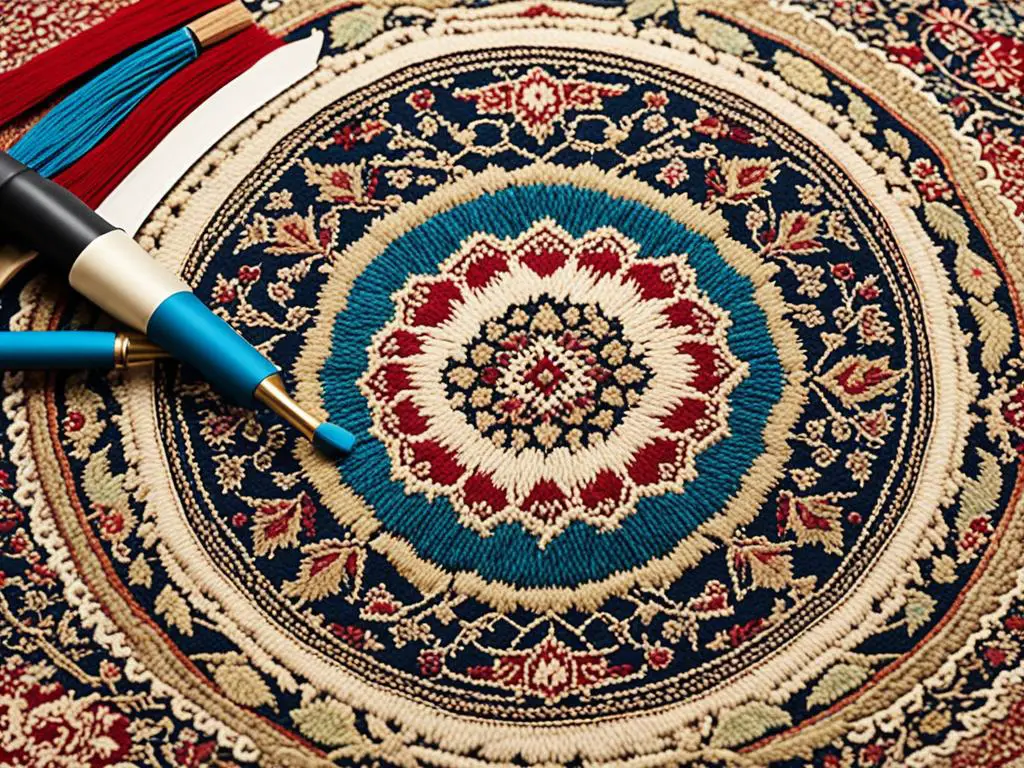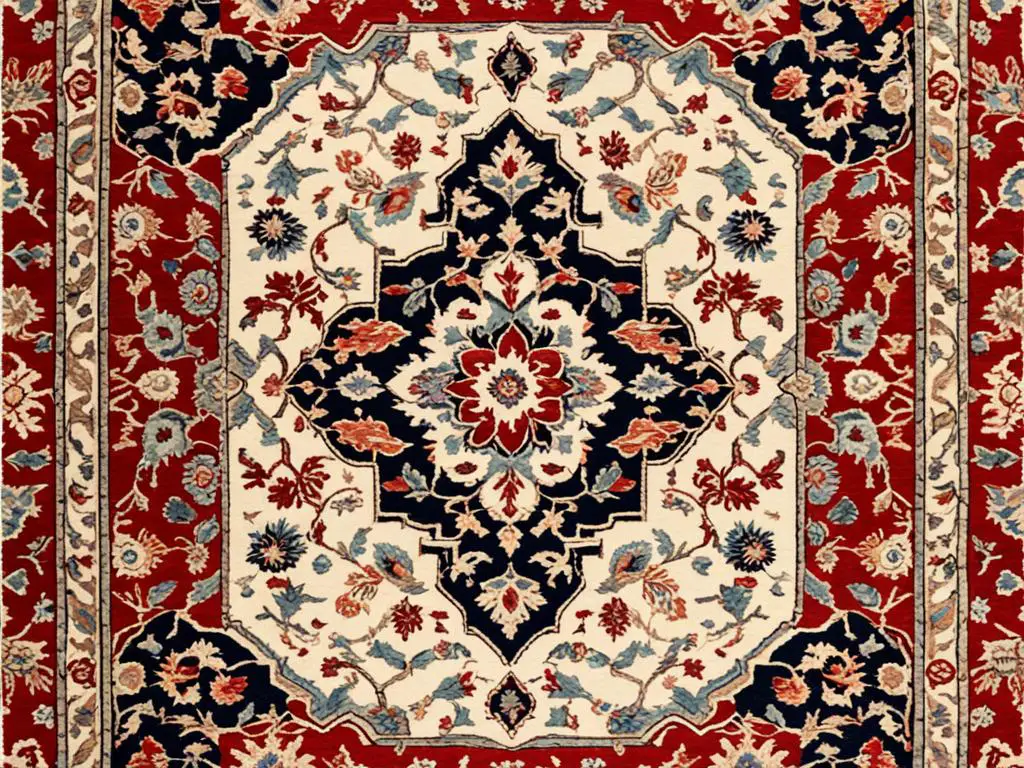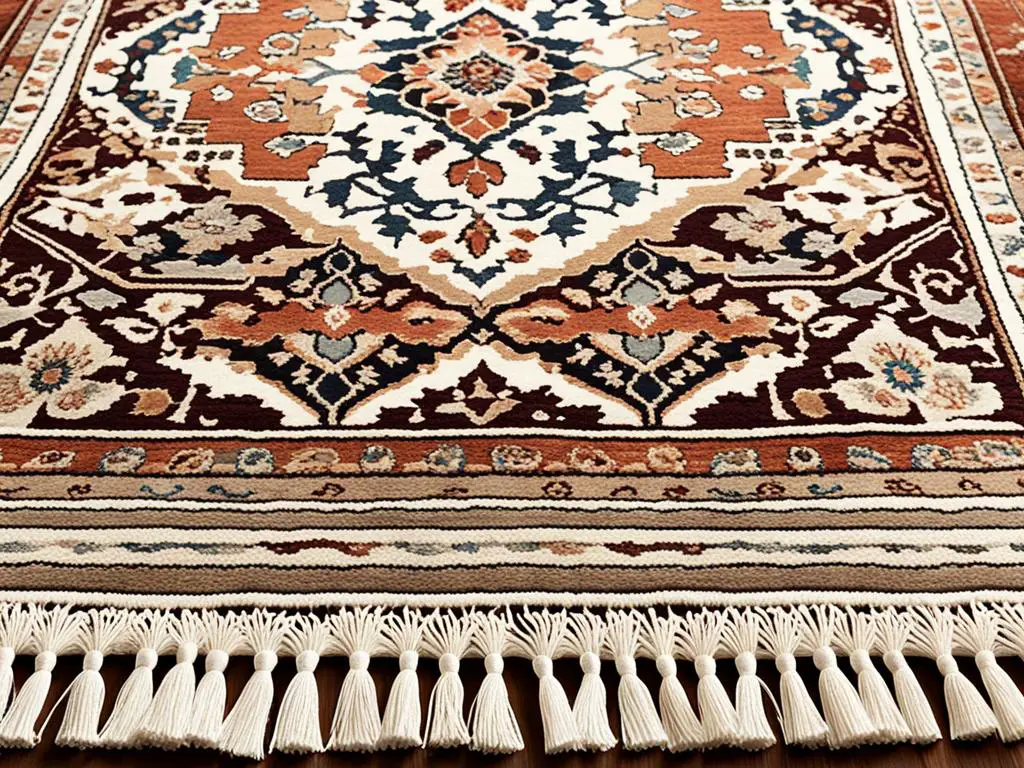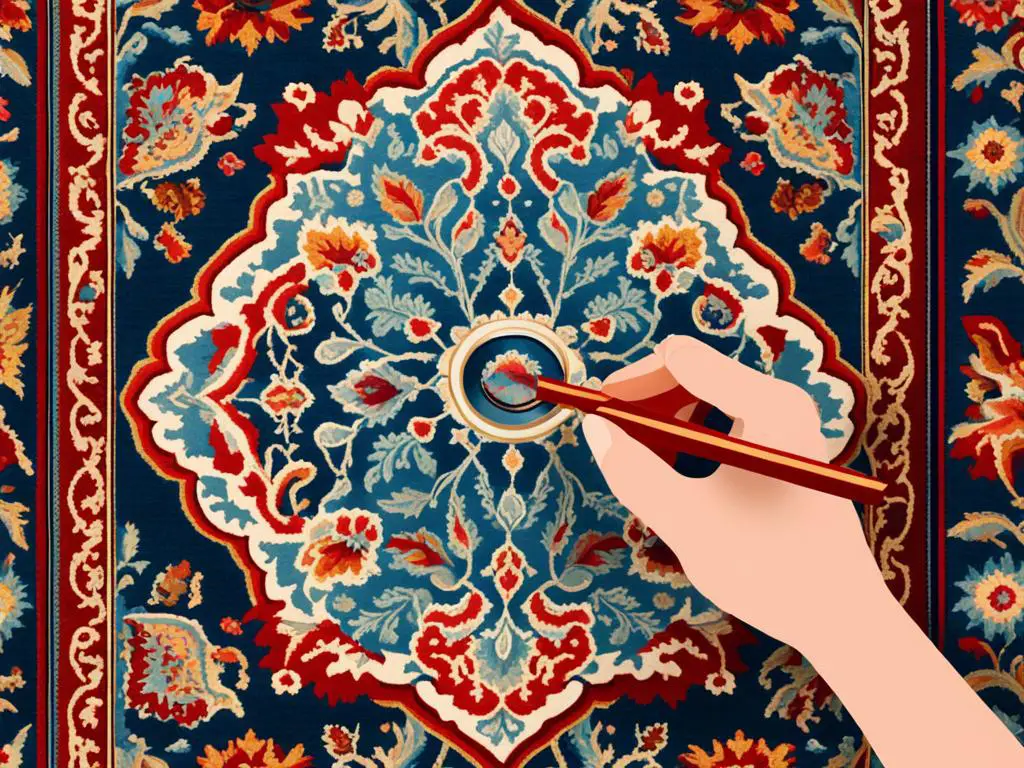Persian rugs are renowned for their beauty and craftsmanship, making them highly sought after by rug enthusiasts and collectors. However, in a market flooded with machine-made rugs and look-a-likes, it can be challenging to identify a genuine Persian rug. To ensure that you are investing in an authentic piece, it is important to know what characteristics to look for.
Key Takeaways:
- Identifying genuine Persian rugs requires attention to specific details.
- Consider the rug’s origin to determine authenticity.
- Hand-knotted rugs are more likely to be authentic compared to hand-tufted rugs.
- Examine the design, fringe, and materials used in the rug.
- Imperfections, seamless integration of the fringe, and natural materials are indicators of a genuine Persian rug.
Finding Out Where the Rug is Made
When it comes to authentic Persian rugs, their origin plays a vital role in determining their true identity. Genuine Persian rugs are exclusively made in Iran, particularly in the Middle Eastern region. Handcrafted with precision and care, these rugs are renowned for their unparalleled beauty and quality.

Unlike machine-made rugs, which are produced in the US and Europe, true Persian rugs are a labor of love created by skilled artisans. The art of hand-knotting rugs has been a traditional craft in Iran for centuries, passed down from one generation to the next.
The Middle Eastern region’s rich history in rug production has shaped the distinctive characteristics of Persian rugs. Each rug tells a story and reflects the culture, artistry, and expertise of the weavers.
It’s important to note that while other countries like Pakistan, India, and China produce hand-knotted rugs, they cannot be considered true Persian rugs unless they are made in Iran. The Iranian origin is what sets authentic Persian rugs apart, underscoring their exceptional value and authenticity.
By understanding the Middle Eastern roots and the hand-knotting technique used in the production of Persian rugs, you can appreciate their unique charm and craftsmanship.
Comparison Between Authentic Persian Rugs and Machine-Made Rugs
| Criteria | Authentic Persian Rugs | Machine-Made Rugs |
|---|---|---|
| Origin | Middle Eastern region, specifically Iran | US and Europe |
| Production Technique | Hand-knotted by skilled artisans | Machine-produced |
| Uniqueness | Each rug is one-of-a-kind | Mass-produced, lacks individuality |
| Value | Highly valuable and sought-after | Lower value compared to authentic Persian rugs |
As we can see from the comparison, the origin and production technique play a significant role in distinguishing authentic Persian rugs from their machine-made counterparts.
“Hand-knotted Persian rugs are like pieces of art that capture the essence of Persian culture, while machine-made rugs lack the soul and craftsmanship that make Persian rugs truly special.”
Differentiating Hand-Knotted and Hand-Tufted Rugs
The construction of a rug plays a vital role in determining its authenticity. Hand-knotted rugs and hand-tufted rugs are two popular types of rug construction. Understanding the differences between these construction methods can help you make an informed decision when purchasing a rug.
Hand-Knotted Rugs:
Hand-knotted rugs are crafted by skilled artisans who meticulously tie each knot by hand. This labor-intensive process ensures exceptional quality and durability. The knots create a dense and firm pile, making hand-knotted rugs highly resilient and long-lasting.
Hand-knotted rugs undergo a time-consuming production process. The weaver starts by tying each individual knot onto the warp threads that form the rug’s foundation. This technique allows for intricate patterns and designs with exceptional attention to detail.
Hand-knotted rugs are known for their exquisite craftsmanship and are often considered investment pieces. They exhibit superior durability and can withstand high foot traffic areas. These rugs can last for generations, making them a valuable addition to any home.
Hand-Tufted Rugs:
Hand-tufted rugs differ in construction from hand-knotted rugs. They are made using a tufting gun, which punches the design into a canvas backing. The process involves creating a stencil-like pattern on the fabric and injecting loops of yarn to form the rug’s pile.
Hand-tufted rugs are less time-consuming to produce compared to hand-knotted rugs, resulting in a more affordable price point. They often showcase vibrant colors and bold patterns, making them popular for contemporary and modern home decor.
While hand-tufted rugs may appear visually appealing initially, they lack the durability and longevity of hand-knotted rugs. Over time, the loops in hand-tufted rugs can loosen and become prone to shedding. These rugs are better suited for low-traffic areas where their vibrant designs can be showcased without enduring excessive wear and tear.
Comparison of Hand-Knotted and Hand-Tufted Rugs:
| Hand-Knotted Rugs | Hand-Tufted Rugs |
|---|---|
| Each knot tied by hand | Punched into a canvas backing |
| Durable and long-lasting | Less durable, prone to shedding |
| Labor-intensive process | Less time-consuming to produce |
| Exquisite craftsmanship | Showcasing vibrant colors and bold designs |
| Superior resilience for high foot traffic areas | Suitable for low-traffic areas |
When choosing between hand-knotted and hand-tufted rugs, consider your budget, intended use, and desired aesthetic. Hand-knotted rugs offer unparalleled quality and durability, while hand-tufted rugs provide affordability and eye-catching designs. Ultimately, both types have their merits, and the decision depends on your unique preferences and needs.

Examining the Design, Fringe, and Material
To determine if a Persian rug is authentic, it is essential to carefully analyze its design, fringe, and material. These aspects can provide valuable insights into the rug’s quality and origin.
One characteristic of handmade rugs, such as Persian rugs, is the presence of slight imperfections and variations in design. Unlike machine-made rugs, which are more uniform and perfect, handmade rugs exhibit the artistry and craftsmanship of the weaver. These imperfections are considered part of the rug’s charm and authenticity, showcasing the human touch that distinguishes it from mass-produced counterparts.
When examining the fringe of a Persian rug, it should seamlessly integrate into the body of the rug. In genuine Persian rugs, the fringe is an integral part of the rug and is formed during the weaving process. It should not appear sewn or attached separately. The fringe’s continuity with the rest of the rug is a clear indication of its authenticity.
Another significant factor to consider is the material of the rug. Authentic Persian rugs are crafted using natural materials such as wool, cotton, or silk. These natural fibers not only contribute to the rug’s lustrous appearance but also enhance its longevity and durability. In contrast, fake Persian rugs may incorporate synthetic materials that lack the same beauty and resilience.

Distinguishing Genuine Persian Rugs
“The imperfections in the design, seamless fringe integration, and use of natural materials are key indicators of a genuine Persian rug. These characteristics reflect the traditional methods and dedication to craftsmanship that make these rugs highly sought after by collectors and enthusiasts alike.”
By carefully examining the design, fringe, and material, you can distinguish authentic Persian rugs from imitations. Their unique imperfections in design, seamless fringe integration, and use of natural materials showcase the rich heritage and traditional craftsmanship of Persian rug making.
Next, let’s explore the differentiating characteristics of hand-knotted and hand-tufted rugs.
Conclusion
Identifying real Persian rugs can be a challenging task, but there are several characteristics and tips that can help you spot an authentic rug. By considering factors such as the origin, construction, design, fringe, and material, you can confidently determine the authenticity of a rug and ensure that you are investing in a genuine Persian masterpiece.
To start, always look for hand-knotted rugs that are made in Iran, the birthplace of true Persian rugs. The intricate craftsmanship and attention to detail in these rugs make them valuable and unique. Additionally, carefully examine the front and back of the rug for slight imperfections and variations, as handmade rugs often display these subtle signs of authenticity.
Another important feature to consider is the fringe. In genuine Persian rugs, the fringe is seamlessly integrated into the rug during the weaving process. If the fringe appears to be sewn onto the rug, it is likely a fake. Lastly, ensure that the rug is made from natural materials such as wool, cotton, or silk, as synthetic materials are often used in fake rugs.
By following these tips and paying attention to the details, you can confidently identify and appreciate genuine Persian rugs, bringing the beauty and craftsmanship of these timeless pieces into your home.



